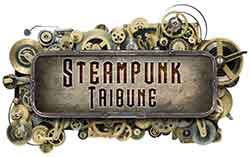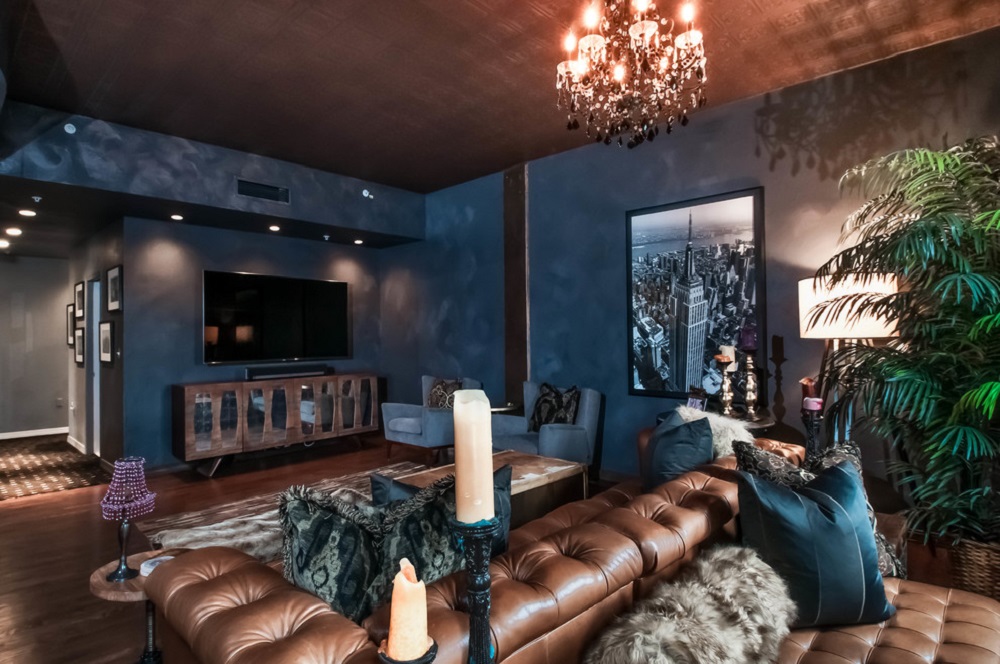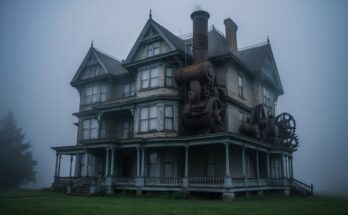Steampunk interior design is a popular trend that has emerged in recent years. This style of design draws inspiration from the Victorian era, industrial culture, and science fiction genre. Steampunk is a subculture that embraces the retro-futuristic aesthetic, and it has become a popular choice for those looking to add a unique touch to their living spaces.
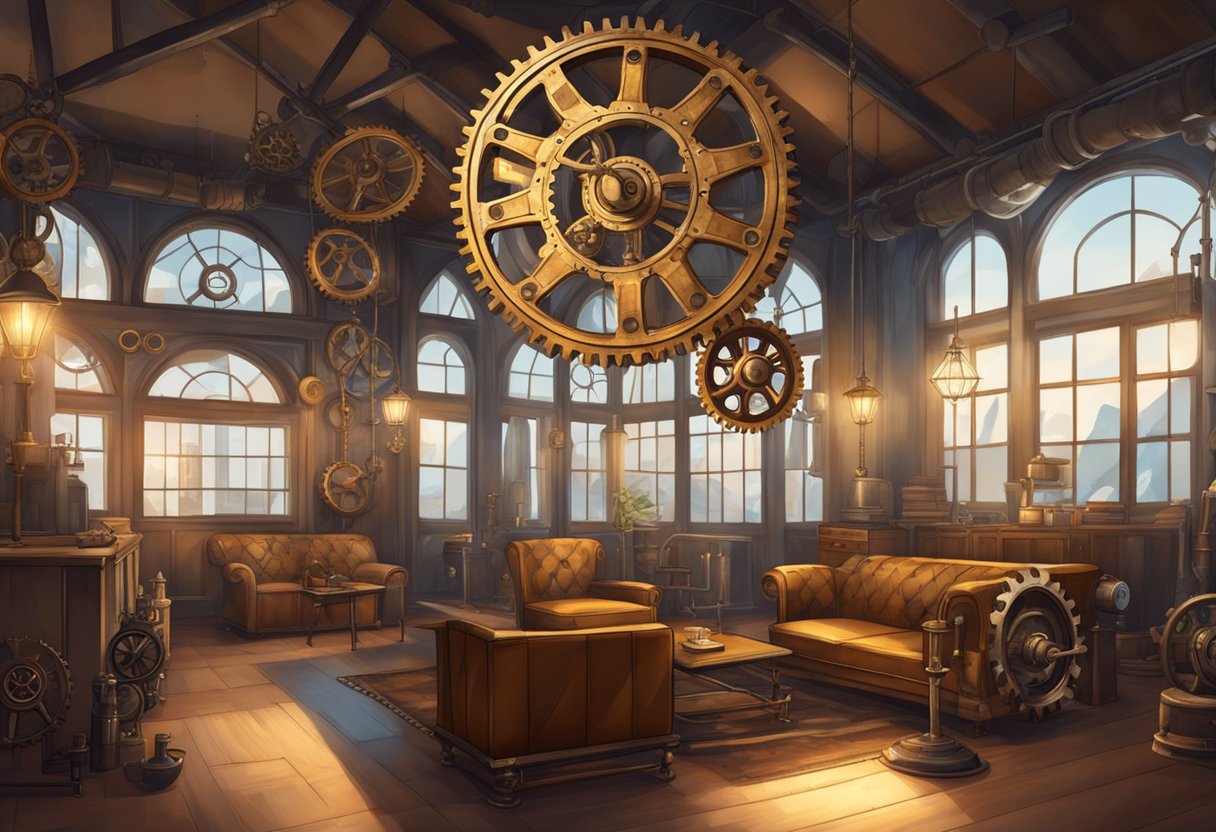
The Victorian era is a key influence in steampunk interior design. This period is known for its ornate and elegant style, which is often reflected in the design elements of steampunk. The use of brass, copper, and other metals is common in steampunk interior design, as is the use of dark woods and rich fabrics. The overall effect is one of opulence and sophistication, with a touch of the industrial thrown in for good measure.
Historical Context and Influences
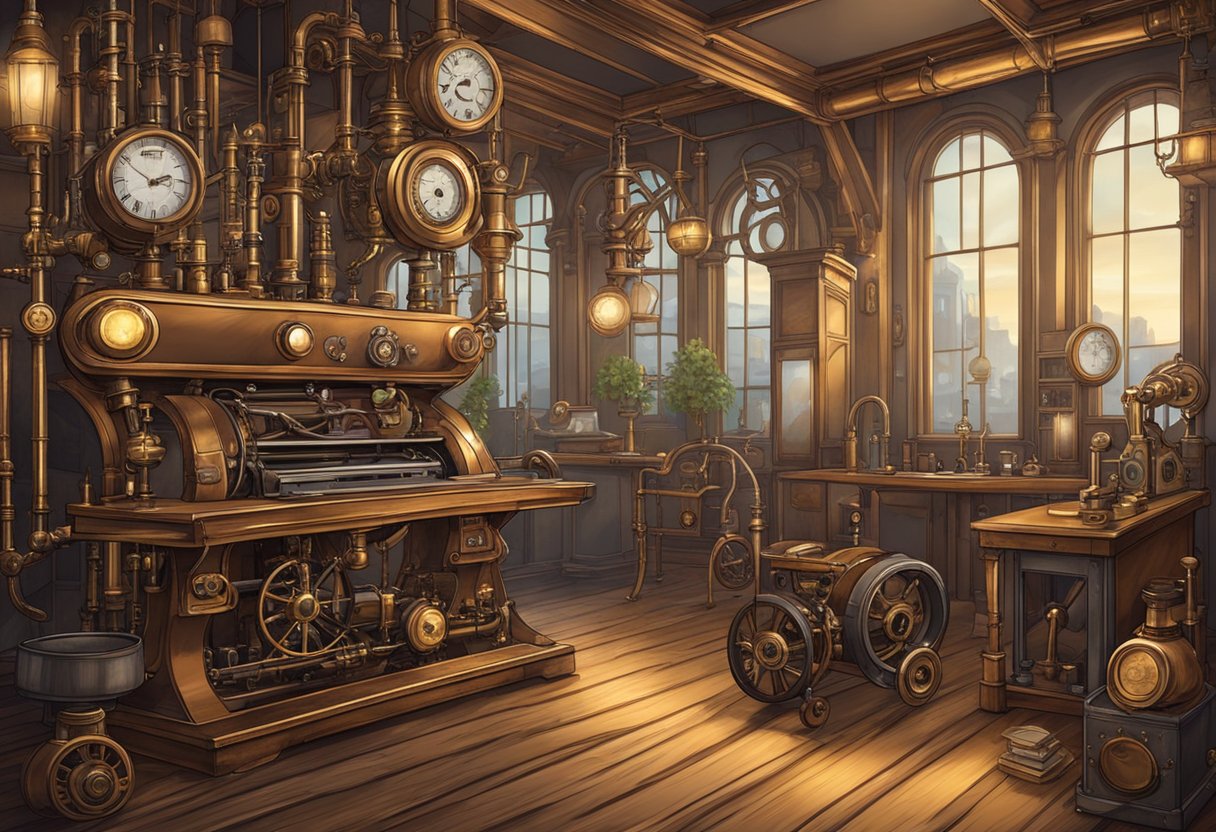
Victorian Era Foundations
Steampunk interior design draws heavily from the Victorian era, which spanned from 1837 to 1901. During this time, advances in technology and industry allowed for the mass production of furniture and decor, leading to the rise of Victorian style. This style is characterized by ornate details, rich colors, and a focus on symmetry.
In addition to the influence of Victorian style, steampunk interior design also takes inspiration from the Victorian fascination with the exotic and the unusual. This can be seen in the use of antique and vintage objects, such as old maps, globes, and scientific instruments, as decorative elements.
Industrial Revolution Impact
The Industrial Revolution, which began in the late 18th century and continued into the 19th century, had a significant impact on the development of steampunk interior design. The widespread use of steam power and the invention of new machinery led to the creation of a wide range of industrial objects, such as gears, pipes, and valves.
These industrial elements are often incorporated into steampunk design, either as functional pieces or as decorative elements. For example, a lamp made from copper pipes and gears might serve as both a light source and a conversation piece.
Literary Inspirations
Steampunk interior design is also influenced by the works of authors such as Jules Verne and Sir Arthur Conan Doyle. Verne’s novels, such as “Journey to the Center of the Earth” and “Twenty Thousand Leagues Under the Sea,” feature fantastical machines and inventions that have become iconic symbols of the steampunk aesthetic.
Similarly, Doyle’s Sherlock Holmes stories take place during the Victorian era and feature intricate plots and detailed descriptions of the period’s architecture and decor. These stories have inspired many steampunk designers to incorporate elements of Victorian style into their work.
Overall, the historical context and influences of steampunk interior design are rooted in the Victorian era, the Industrial Revolution, and the works of influential authors. By drawing on these sources, designers are able to create unique and visually striking spaces that combine the best of the past and the present.
Defining Steampunk Style
Steampunk style is a unique and intriguing design aesthetic that combines elements of Victorian-era machinery and technology with a modern, industrial twist. It is a style that has grown in popularity over the years, with many designers and homeowners embracing the look and feel of this distinctive design trend.
Key Elements of Steampunk Aesthetics
The key elements of steampunk aesthetics include a focus on machinery, technology, and industrial design. This can be seen in the use of gears, cogs, and other mechanical components, as well as the incorporation of vintage machinery and technology into the design.
Materials and Textures
The materials and textures used in steampunk interior design are often a mix of metal, leather, lace, and wood. These materials help to create a sense of warmth and texture in the space, while also adding to the overall industrial feel of the design.
Color Schemes and Tones
The color scheme used in steampunk interior design is often muted and sepia-toned, with a focus on metallic tones such as brass, copper, bronze, and iron. These colors help to create a sense of warmth and depth in the space, while also adding to the overall industrial feel of the design.
In summary, steampunk style is a unique and intriguing design aesthetic that combines elements of Victorian-era machinery and technology with a modern, industrial twist. The key elements of this design trend include a focus on machinery, technology, and industrial design, with materials such as metal, leather, lace, and wood being used to create a sense of warmth and texture in the space. The color scheme used in steampunk interior design is often muted and sepia-toned, with a focus on metallic tones such as brass, copper, bronze, and iron.
Room-Specific Steampunk Design Ideas
Steampunk interior design is all about creating a unique and vintage look with a modern twist. By incorporating industrial elements, Victorian-era aesthetics, and science fiction motifs, you can create a space that is both functional and visually stunning. Here are some room-specific steampunk design ideas that you can use to transform your home.
Living Room Envisioning
The living room is the heart of the home, and it’s the perfect place to showcase your steampunk design style. Start by choosing furniture pieces that have an industrial look, such as leather sofas, metal coffee tables, and distressed wood bookcases. Add vintage accessories like old clocks, globes, and typewriters to create a sense of nostalgia. Finally, incorporate unique lighting fixtures like Edison bulbs and steampunk-inspired lamps to complete the look.
Bedroom with a Steampunk Twist
The bedroom is a place of relaxation, and a steampunk-inspired design can help create a cozy and inviting atmosphere. Start by choosing a metal bed frame with intricate detailing, such as gears or cogs. Add vintage-style bedding with lace or ruffles, and accessorize with old-fashioned alarm clocks, antique mirrors, and vintage suitcases. Finally, incorporate unique lighting fixtures like pendant lights or table lamps with Edison bulbs to create a warm and inviting ambiance.
Kitchen and Dining Area
The kitchen and dining area are perfect places to incorporate steampunk design elements. Start by choosing furniture pieces with an industrial look, such as metal bar stools and distressed wood dining tables. Add vintage accessories like old-fashioned tea kettles, copper pots, and cast iron skillets to create a sense of nostalgia. Finally, incorporate unique lighting fixtures like pendant lights with exposed bulbs to complete the look.
Bathroom and Functional Spaces
The bathroom and other functional spaces are often overlooked when it comes to design, but they can still benefit from a steampunk-inspired look. Start by choosing vintage-style fixtures like clawfoot tubs, pedestal sinks, and exposed pipe showers. Add industrial elements like metal shelving and vintage medicine cabinets to create a sense of history. Finally, incorporate unique lighting fixtures like sconces with Edison bulbs to create a warm and inviting ambiance.
In conclusion, steampunk interior design can be a fun and unique way to transform your home. By incorporating industrial elements, Victorian-era aesthetics, and science fiction motifs, you can create a space that is both functional and visually stunning. Use these room-specific steampunk design ideas to help bring your vision to life.
Furniture and Accessories
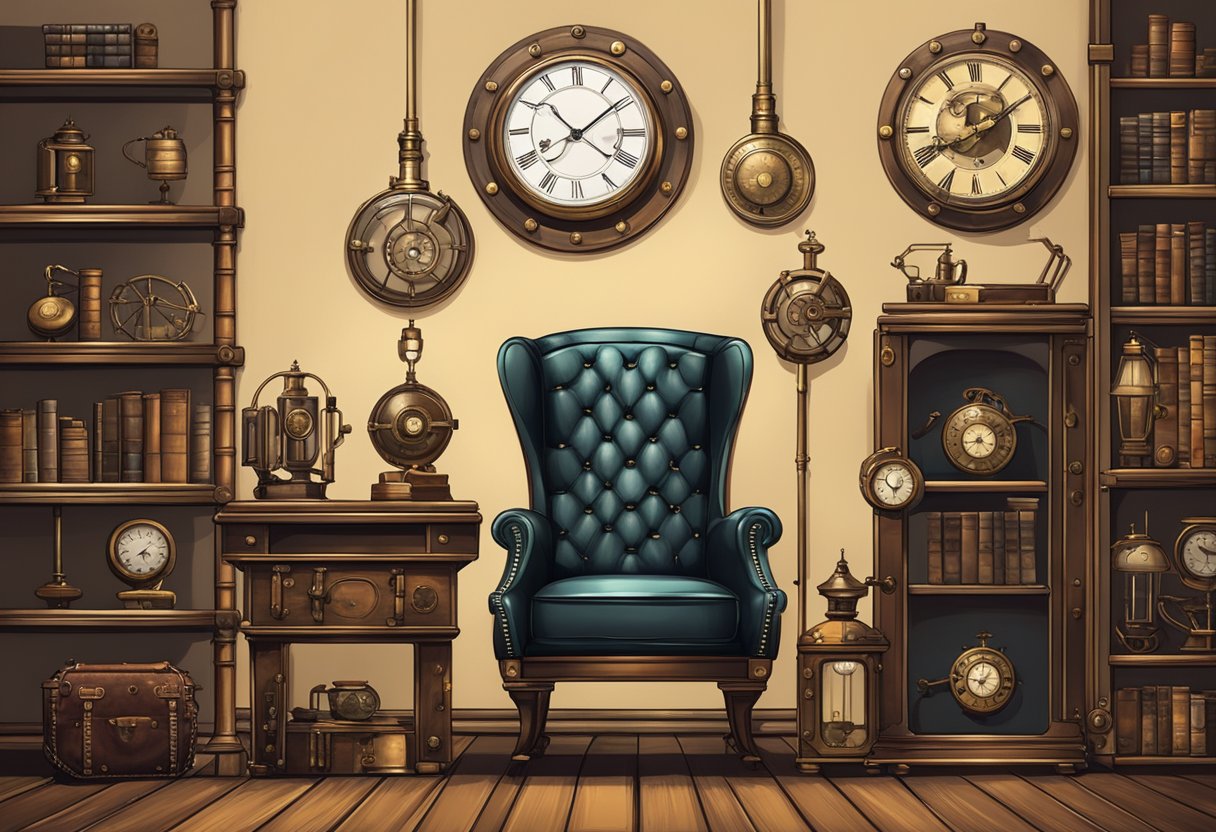
Choosing Steampunk Furniture
When it comes to choosing furniture for a steampunk interior, the key is to look for pieces that have a vintage, industrial feel. Antique furniture, leather sofas, and bookshelves are all great options. Chairs with metal frames and worn leather upholstery can add a touch of ruggedness to the space.
Gears and clocks are also common motifs in steampunk design, so incorporating functional and decorative timepieces can add an interesting element to the room. A compass or a vintage map can also add to the adventurous feel of the space.
Decorative Accessories and Artifacts
In addition to furniture, accessories and artifacts can help complete the steampunk look. Hats, typewriters, and antique books can all add to the vintage feel of the room. Clocks, gears, and other mechanical objects can also be used as decorative pieces.
When choosing decorative accessories, it’s important to keep in mind the overall aesthetic of the room. Accessories should be chosen with care to ensure they complement the furniture and other elements of the space.
Overall, when designing a steampunk interior, the key is to focus on vintage, industrial pieces that convey a sense of adventure and exploration. By incorporating furniture and accessories that fit this aesthetic, it’s easy to create a space that feels both unique and inviting.
Incorporating Technology and Mechanisms
Steampunk interior design is all about blending the old with the new. One of the ways to achieve this is by incorporating technology and mechanisms into the design. This can be done in various ways, including adding mechanical and industrial features, as well as modern gadgets with a steampunk makeover.
Mechanical and Industrial Features
Mechanical and industrial features are a key aspect of steampunk interior design. This can include adding piping, pipes, rivets, and other mechanical elements to the design. These features can be incorporated into furniture pieces, such as lamps, tables, and chairs, as well as into the walls and ceilings of the room.
One way to incorporate mechanical and industrial features is by using exposed pipes as a decorative element. This can be done by painting the pipes in a metallic finish or by leaving them in their natural state. Rivets can also be used to add an industrial touch to furniture pieces and walls, while gears and cogs can be used to create unique and eye-catching designs.
Modern Gadgets with a Steampunk Makeover
Another way to incorporate technology into steampunk interior design is by giving modern gadgets a steampunk makeover. This can include adding brass and copper finishes, as well as gears and cogs, to modern gadgets such as smartphones and laptops.
One example of a modern gadget with a steampunk makeover is a USB drive that has been designed to look like a vintage pocket watch. This type of gadget combines modern technology with a vintage aesthetic, creating a unique and functional piece that fits perfectly into a steampunk-inspired room.
Incorporating technology and mechanisms into steampunk interior design can add a unique and interesting touch to any room. By using mechanical and industrial features and giving modern gadgets a steampunk makeover, designers can create a space that is both functional and visually appealing.
DIY and Customization
Steampunk interior design is all about creating a unique and personalized living space. One way to achieve this is through DIY and customization. With a little creativity and effort, anyone can create their own steampunk pieces and refurbish existing ones to fit the aesthetic.
Creating Your Own Steampunk Pieces
One of the most exciting aspects of steampunk design is the opportunity to create your own unique pieces. DIY projects can range from simple to complex, depending on your skill level and available resources. For example, you can create a steampunk-inspired desk lamp by repurposing old pipes and gears, or you can craft a decorative wall clock using vintage watch parts.
When creating your own steampunk pieces, it’s important to keep in mind the key elements of the aesthetic. Industrial materials such as metal, wood, and leather are often used, as well as Victorian-inspired textiles like velvet and linen. Additionally, incorporating gears, cogs, and other mechanical elements can add a touch of authenticity to your DIY projects.
Refurbishing and Repurposing
Another way to incorporate steampunk design into your home is through refurbishing and repurposing existing furniture and decor. Refurbished furniture can add character and charm to a room, while repurposed decor can serve as functional and unique pieces.
For example, an old wooden trunk can be transformed into a steampunk-inspired coffee table by adding metal accents and industrial-style legs. A vintage typewriter can be repurposed into a decorative piece by adding gears and cogs to the exterior.
When refurbishing and repurposing items, it’s important to consider the overall aesthetic of the room. Adding steampunk elements to a modern or minimalist space may require a more subtle approach, while a more traditional or eclectic room can handle bolder design choices.
In conclusion, DIY and customization are essential components of steampunk interior design. Creating your own pieces and refurbishing existing ones can add a personal touch to your living space while staying true to the aesthetic. Whether you’re a seasoned crafter or a beginner, there are endless possibilities for incorporating steampunk design into your home.
Lighting and Atmosphere
Choosing the Right Lighting
Lighting plays a crucial role in creating a steampunk atmosphere. It is important to choose the right lighting fixtures that complement the overall theme of the room. Lanterns are a popular choice for steampunk lighting as they give off a warm, cozy glow. Stained glass lamps are also a great option, as they add a touch of elegance and sophistication to the room. Cogs and gears can be incorporated into the design of the lighting fixtures to give them a more industrial look.
In addition to choosing the right type of lighting fixture, it is important to consider the color temperature of the bulbs. Warm white or yellow bulbs are ideal for creating a cozy and inviting atmosphere, while cooler white bulbs can give the room a more sterile and industrial feel. Dimmer switches can also be used to adjust the brightness of the lights and create a more intimate atmosphere.
Creating an Immersive Environment
To fully immerse oneself in the steampunk world, it is important to consider the overall atmosphere of the room. A fireplace can add warmth and coziness to the space, while also providing a focal point for the room. Stained glass windows or panels can be used to add a touch of elegance and sophistication to the room.
Incorporating industrial elements such as cogs, gears, and pipes into the design of the room can also help to create an immersive environment. These elements can be incorporated into the lighting fixtures, furniture, and decor to give the room a more industrial feel.
Overall, creating a steampunk atmosphere requires careful consideration of the lighting and overall atmosphere of the room. By choosing the right lighting fixtures and incorporating industrial elements into the design, one can create a truly immersive and unique steampunk space.
Cultural and Global Influence
Steampunk in Modern Culture
Steampunk has become a popular subculture in recent years, with its influence extending beyond just the world of interior design. It has been incorporated into fashion, music, and even literature. The popularity of steampunk can be attributed to its unique blend of Victorian-era aesthetics and futuristic technology.
In fashion, steampunk has inspired a range of styles, from vintage-inspired clothing to futuristic cyberpunk looks. Steampunk music draws from a variety of genres, including industrial, goth, and classical music. The steampunk subculture has also inspired a range of literature, including books by authors such as China Miéville and Philip Pullman.
Global Festivals and Events
Steampunk festivals and events have become increasingly popular around the world, attracting enthusiasts from all walks of life. One of the most well-known events is the Steampunk World’s Fair, which takes place annually in New Jersey, USA. The festival features a range of activities, including live music performances, fashion shows, and workshops.
In New Zealand, the Steampunk HQ museum in Oamaru showcases a range of steampunk-inspired art and design. The museum also hosts an annual steampunk festival, which includes live music, fashion shows, and art exhibitions.
Overall, the cultural and global influence of steampunk is evident in its growing popularity and its incorporation into various aspects of modern culture. Its unique blend of vintage aesthetics and futuristic technology has captured the imagination of people around the world.
Conclusion
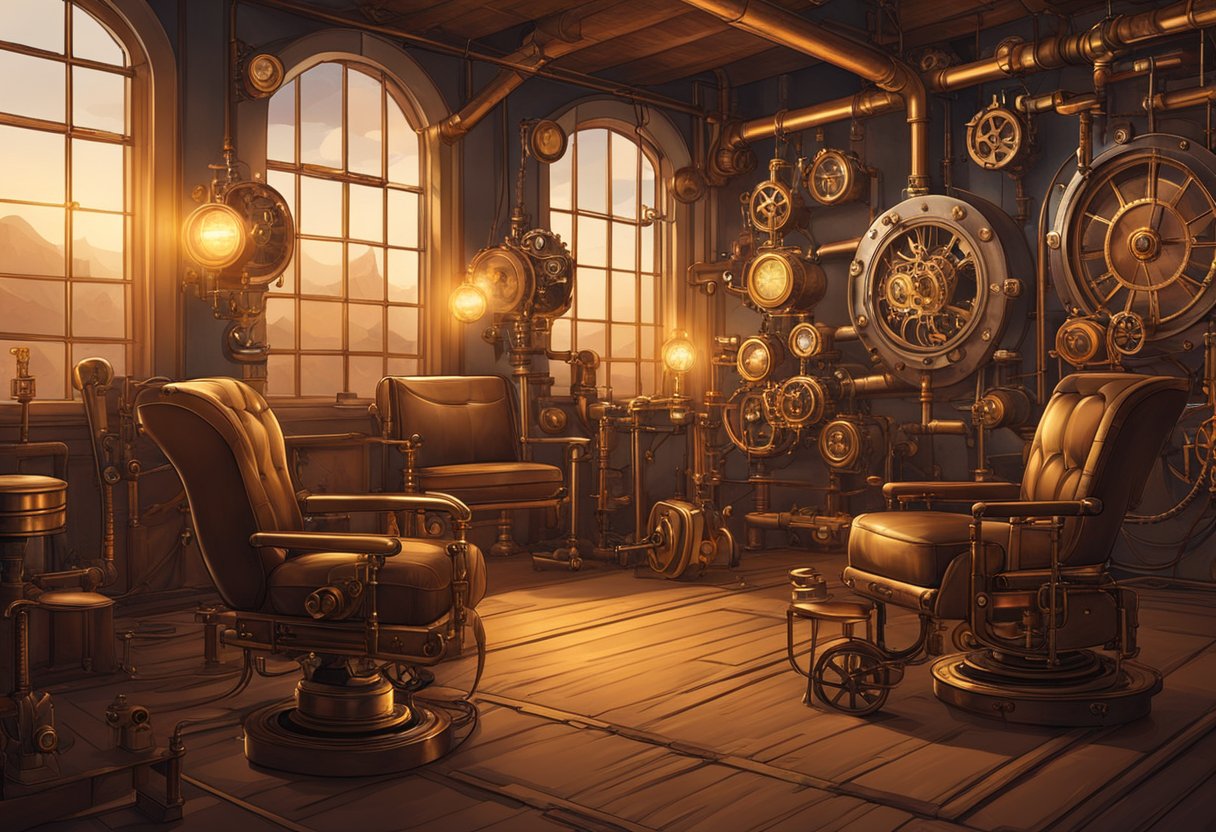
In conclusion, Steampunk Interior Design is a fascinating blend of Victorian aesthetics and industrial machinery. It provides a unique and rich cultural experience for those who appreciate the beauty of the past and the future.
Through the discovery of steampunk design, individuals can delve deep into the intricacies of the past and explore the potential of the future. The incorporation of vintage and industrial elements into interior design creates a sense of nostalgia while also providing a fresh and modern twist.
Steampunk Interior Design is not limited to a specific audience or demographic. It can be enjoyed by anyone who appreciates the beauty of art and design. The style is versatile and can be incorporated into any space, from residential to commercial.
Overall, Steampunk Interior Design is a unique and captivating design style that offers a deep and rich cultural experience. It allows individuals to explore the beauty of the past while discovering the potential of the future.
